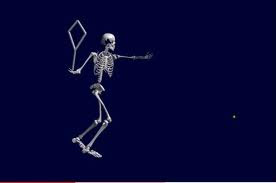Charlie,
So where does the bulk of the power come from? What should I focus on to generate as much power as I could? Legs, hip, shoulder, or what? Thanks.
What's the exercise for that?
You've already got great answers above - there just is no one "secret" that will unlock more power.
Clearly, the source of power in tennis is using all the components of the kinetic chain firing precisely at the right time - any lag or early firing interferes with the build up in power.
The above is an approximation - we can't break a person down an isolate one aspect like we can a machine.
If you want an intellectual understanding of the biomechanics of the serve and forehand, I would urge you take even the limited subscription to tennisplayer.net and read the fascinating analyses by Brian Gordon [I think he does a great job of explaining his pioneering computer modeling research in easy to understand terminology.]
(Because of copyright laws, I don't have a sample of the system he uses, but it perhaps can be considered an extension of the APAS system analysis developded by Vic Braden and And Fitzell. Even without narration or explanation, your own observation can see the leg pushoff, core/hip rotation, setting up the arm in the correct orientation to transfer all that power eventually through the wrist/hand/racquet to the ball.
Roger Federer Forehand on the APAS System
http://www.youtube.com/watch?v=pPLmCqGIotM
Andy Roddick Serve on the APAS System
http://www.youtube.com/watch?v=kqSKBBxO3qU
[A word on timing. Because Brian Gordon can place sensors all over any tennis players body, he can determine not only if all the body movements are correct, but if they are firing their legs, shoulders, or arms a tiny fraction of a second too early or too late so that they can begin corrective action.
http://www.3d-tennis.com/ocuspta/bestfh.html ]
This thread is about "wrist snap".
As mentioned above the bulk of power comes from the whole body acting in a co-ordinated fashion.
Just as the power in a car is its engine and the gears and differential "only" serve to transfer the power to the wheels, so too does the wrist "only" transfer the power to hand/racket.
But engineers spend countless hours working on gearboxes and differentials to transfer that power to the engine.
It is only natural that we tennis players try to understand what is happening at the wrist to transfer that energy from the body through the hand and racquet to the ball.
What exercise to do?
A basic principle is that the closer the exercise is to the sports activity, the quicker you see results.
So spending more time practicing/playing tennis - and being certain you have correct technique - leads to the quickest gains in power.
But there are three problems with only playing tennis and not doing an off court conditioning program:
1. Muscular weakness prevents proper stroke set up/execution. Many have weaknesses that prevent them from doing what the pros do for power [an example would be difficulty balancing going into a deep knee bend, shoulder wind and backward lean from the heels in the trophy position - some players really need to do squats to have the leg, core and muscles that connect the leg to the core strength to get into a powerful trophy position from which they can explode.]
2. Overuse injuries. Tennis requires countless hours on the court practicing bashing the ball. The "hitting muscles" are getting stronger and stronger and can overpower the "resisting" or "stopping" muscles. Too much energy is then
transferred to non-elastic ligaments, tendons and joints. Overuse injuries result. Doing off court strengthening exercises increases the strength in elastic muscle to absorb all the hitting energy, and allow a player to bash with a decreased chance of incurring an overuse injury.
3. Explosive plyometric exercises cause overuse injuries. Many players decide to take up explosive jumping and medicine ball throwing exercises to increase power [Power = Force x Velocity]. But explosive power exercises have a high liklehood of causing overuse injuries for the same reason I described above for tennis overuse injuries. Only now those players are doing two activities that may result in an overuse injury - plyometrics plus tennis! Any surprise many "break down"? So a period of increasing overall strength better prepares the muscles/tendons/ligaments/joints to absorb plyometrics and tennis.
For all the above reasons, a total body workout program divided into strength gains before plyometrics is recommended. If you are interested, I urge you to read The Elite Approach to Tennis Strength Training
http://www.sport-fitness-advisor.com/tennis-strength-training.html
In it, there is a stress on a shoulder, forearm and wrist program of exercises done concurrently. The exercises listed are good, but the best I have found for this is the Thrower's Ten Exercises
http://www.muhlenberg.edu/pdf/main/athletics/athletic_training/throwers10.pdf
I hope this helps.





